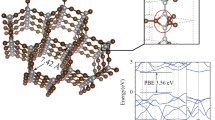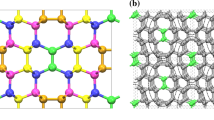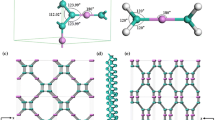Abstract
A novel sp3 + sp2 hybridized carbon allotrope in the P4/mmm phase, denoted as tP48 carbon, is proposed and predicted according to density functional theory. The tP48 carbon allotrope is mechanically, dynamically, and thermodynamically stable. The bulk modulus, B, of tP48 carbon is slightly larger than that of other carbon allotropes in the tP family. Of the tP family of carbon materials, tP48 carbon exhibits the greatest anisotropy in terms of its Young’s modulus, E, Poisson’s ratio, v, and shear modulus, G. In regards to its electronic band structure, tP48 carbon is an indirect semiconductor material with a band gap of 1.516 eV. The XRD characteristics of tP48 carbon are also studied in this work, with the associated characteristics found to be of guiding significance for determining the structure of tP48 carbon in subsequent experiments.








Similar content being viewed by others
References
L.M. Peng, Z.Y. Zhang, S. Wang et al., Carbon based nanoelectronics: materials and devices. Sci. Sin. Tech. 44, 1071–1086 (2014) (in Chinese).
M. **ng and X. Li, Designing sp3 networks of two novel carbon allotropes in the P4/mmm phase. Chin. J. Phys. 75, 90–103 (2022).
C. He, X. Shi, S. Clark, J. Li, C. Pickard, T. Ouyang, C. Zhang, C. Tang, and J. Zhong, Complex low energy tetrahedral polymorphs of group IV elements from first principles. Phys. Rev. Lett. 121, 175701 (2018).
M. **ng, C. Qian, and X. Li, Two novel carbon allotropes with tetragonal symmetry: first-principles calculations. J. Solid State Chem. 309, 122971 (2022).
F. Delodovici, N. Manini, R. Wittman, D. Choi, M. Fahim, and L. Burchfield, Protomene: a new carbon allotrope. Carbon 126, 574–579 (2018).
N. Nulakani and V. Subramanian, Superprismane: a porous carbon allotrope. Chem. Phys. Lett. 715, 29–33 (2019).
Z. Ma, J. Zuo, C. Tang, P. Wang, and C. Shi, Physical properties of a novel phase of boron nitride and its potential applications. Mater. Chem. Phys. 252, 123245 (2020).
X. Yu, R. Su, and B. He, A novel BN polymorph with ductile manner. J. Solid State Chem. 306, 122794 (2022).
Q. Fan, N. Wu, S. Chen, L. Jiang, W. Zhang, X. Yu, and S. Yun, P213 BN: a novel large-cell boron nitride polymorph. Commun. Theor. Phys. 73, 125701 (2021).
Q. Wang, B. Xu, J. Sun, H. Liu, Z. Zhao, D. Yu, C. Fan, and J. He, Direct band gap silicon allotropes. J. Am. Chem. Soc. 136, 9826–9829 (2014).
X. Cai, Q. Yang, Y. Pang, and M. Wang, A theoretical prediction of a new silicon allotrope: tP36-Si. Comput. Mater. Sci. 173, 109441 (2020).
Q.Y. Fan, Y.C. Sun, Y.B. Zhao, Y.X. Song, and S.N. Yun, Group 14 elements in the Cmcm phase with a direct band structure for photoelectric application. Phys. Scr. 98, 015701 (2023).
N. Zhou, P. Zhou, J. Li, C. He, and J. Zhong, Si-Cmma: a silicon thin film with excellent stability and Dirac nodal loop. Phys. Rev. B. 100, 115425 (2019).
Q. Fan, B. Hao, Y. Zhao, Y. Song, W. Zhang, and S. Yun, Si–C alloys with direct band gaps for photoelectric application. Vac. 199, 110952 (2022).
X. Zhang, C. Ying, S. Quan, G. Shi, and Z. Li, Ab initio study of the structural, phonon, elastic and thermodynamic properties of the ordered Ge0.5Sn0.5 cubic alloy under high pressure. Comput. Mater. Sci. 58, 12–16 (2012).
X. Shi, S. Li, J. Li, T. Ouyang, C. Zhang, C. Tang, C. He, and J. Zhong, High-throughput screening of two-dimensional planar sp2 carbon space associated with a labeled quotient graph. J. Phys. Chem. Lett. 12, 11511 (2021).
W. Zhang, C. Chai, Q. Fan, Y. Song, and Y. Yang, Two-dimensional carbon allotropes with tunable direct band gaps and high carrier mobility. Appl. Surf. Sci. 537, 147885 (2021).
M. Sun, Y. Yan, and U. Schwingenschlögl, Beryllene: a promising anode material for Na- and K-ion batteries with ultrafast charge/discharge and high specific capacity. J. Phys. Chem. Lett. 11(21), 9051–9056 (2020).
Z. Gong, X. Shi, J. Li, S. Li, C. He, T. Ouyang, C. Zhang, C. Tang, and J. Zhong, Theoretical prediction of a low-energy Stone–Wales graphene with intrinsic type-III Dirac-cone. Phys. Rev. B. 101, 155427 (2020).
M. Sun and U. Schwingenschlögl, δ-CS: a direct-band-gap semiconductor combining auxeticity, ferroelasticity, and potential for high-efficiency solar cells. Phys. Rev. Appl. 14, 044015 (2020).
M. **ng and X. Li, An orthorhombic carbon allotrope with a quasi-direct band gap and superhard. Diam. Relat. Mater. 131, 109592 (2023).
X. Li and M. **ng, Prediction of a novel carbon allotrope from first-principle calculations: a potential superhard material in monoclinic symmetry. Mater. Chem. Phys. 242, 122480 (2020).
Q. Fan, H. Gao, R. Yang, W. Zhang, X. Yu, and S. Yun, A superhard orthorhombic carbon allotrope. Chin. J. Phys. 79, 409–419 (2022).
X. Wu, X. Shi, M. Yao, S. Liu, X. Yang, L. Zhu, T. Cui, and B. Liu, Superhard three-dimensional carbon with metallic conductivity. Carbon 123, 311–317 (2017).
L. Liu, M. Hu, Z. Zhao, Y. Pan, and H. Dong, Superhard conductive orthorhombic carbon polymorphs. Carbon 158, 546–552 (2020).
Q. Fan, H. Liu, L. Jiang, W. Zhang, Y. Song, Q. Wei, X. Yu, and S. Yun, Three-dimensional metallic carbon allotropes with superhardness. Nanotechnol. Rev. 10, 1266–1276 (2021).
Y. Liu, X. Jiang, J. Fu, and J. Zhao, New metallic carbon: three dimensionally carbon allotropes comprising ultrathin diamond nanostripes. Carbon 126, 601–610 (2018).
W. Zhang, C. Chai, Y. Song, Q. Fan, and Y. Yang, 3D superhard metallic carbon network with 1D multithreaded conduction. Diam. Relat. Mater. 120, 108706 (2021).
Q. Fan, R. Zhao, L. Jiang, W. Zhang, Y. Song, and S. Yun, Ima2 C32: an orthorhombic carbon allotrope with direct band gap. Diam. Relat. Mater. 120, 108602 (2021).
W. Zhang, C. Chai, Q. Fan, Y. Song, and Y. Yang, Penta-C20: a superhard direct band gap carbon allotrope composed of carbon pentagon. Mater. 13(8), 1926 (2020).
Z. Zhang, H. Liu, and M. Zhang, Superhard sp3 carbon allotrope: Ab initio calculations. EPL 108(4), 46006 (2014).
X. Yang, C. Lv, S. Liu, J. Zang, J. Qin, M. Du, D. Yang, X. Li, B. Liu, and C. Shan, Orthorhombic C14 carbon: a novel superhard sp3 carbon allotrope. Carbon 156, 309–312 (2020).
Z. Li, M. Hu, M. Ma, Y. Gao, B. Xu, J. He, D. Yu, Y. Tian, and Z. Zhao, Superhard superstrong carbon clathrate. Carbon 105, 151–155 (2016).
Y. Oh, S. Kim, I. Lee, J. Lee, and K. Chang, Direct band gap carbon superlattices with efficient optical transition. Phys. Rev. B. 93, 085201 (2016).
F. Delodovici, N. Manini, R. Wittman, D. Choi, A. Mohamed, and L. Burchfield, Protomene: a new carbon allotrope. Carbon 126, 574–579 (2018).
Y. Gao, X. Feng, B. Gong, C. Zhong, S. Yang, K. Liu, and Z. Lu, Theoretical design of all-carbon networks with intrinsic magnetism. Carbon 177, 11–18 (2021).
X. Shi, C. He, C. Pickard, C. Tang, and J. Zhong, Stochastic generation of complex crystal structures combining group and graph theory with application to carbon. Phys. Rev. B. 97, 014104 (2018).
R. Hoffmann, A. Kabanov, A. Golov, and D. Proserpio, Homo citans and carbon allotropes: for an ethics of citation. Angew. Chem. Int. Ed. 55, 10962–10976 (2016).
M. O’Keeffe, M. Peskov, S. Ramsden, and O. Yaghi, The reticular chemistry structure resource (RCSR) database of, and symbols for, crystal nets. Acc. Chem. Res. 41, 1782–1789 (2008).
M.O’Keeffe, O. Yaghi, S. Ramsden, Reticular chemistry structure resource, Australian National University Supercomputer Facility. http://rcsr.anu.edu.au/. Accessed 1 February 2022.
P. Hohenberg and W. Kohn, Inhomogeneous electron gas. Phys. Rev. 136(3B), B864–B871 (1964).
W. Kohn and L.J. Sham, Self-consistent equations including exchange and correlation effects. Phys. Rev. 140, A1133 (1956).
J. Perdew, K. Burke, and M. Ernzerhof, Generalized gradient approximation made simple. Phys. Rev. Lett. 77, 3865 (1996).
S. Clark, M. Segall, C. Pickard, P. Hasnip, M. Probert, and K. Refson, First principles methods using CASTEP. Z. Krist. 220, 567–570 (2005).
H. Monkhorst and J. Pack, Special points for Brillouin-zone integrations. Phys. Rev. B. 13, 5188 (1976).
B. Pfrommer, M. Cote, S. Louie, and M. Cohen, Relaxation of crystals with the quasi-Newton method. J. Comput. Phys. 131, 233–240 (1997).
A. Krukau, O. Vydrov, A. Izmaylov, and G. Scuseria, Influence of the exchange screening parameter on the performance of screened hybrid functionals. J. Chem. Phys. 125, 224106 (2006).
S. Baroni, S. Gironcoll, A. Corso, and P. Glannozzi, Phonons and related crystal properties from density-functional perturbation theory. Rev. Mod. Phys. 73, 515 (2001).
Q. Fan, H. Wang, Y. Song, W. Zhang, and S. Yun, Five carbon allotropes from Squaroglitter structures. Comput. Mater. Sci. 178, 109634 (2020).
X. Sheng, Q. Yan, F. Ye, Q. Zheng, and G. Su, T-carbon: a novel carbon allotrope. Phys. Rev. Lett. 106, 155703 (2011).
J. Zhang, R. Wang, X. Zhu, A. Pan, C. Han, X. Li, Z. Dan, C. Ma, W. Wang, H. Su, and C. Niu, Pseudo-topotactic conversion of carbon nanotubes to T-carbon nanowires under picosecond laser irradiation in methanol. Nat. Commun. 8, 683 (2017).
F. Mouhat and F. Coudert, Necessary and sufficient elastic stability conditions in various crystal systems. Phys. Rev. B. 90, 224104 (2014).
Z. Wu, E. Zhao, H. **ang, X. Hao, X. Liu, and J. Meng, Crystal structures and elastic properties of superhard IrN2 and IrN3 from first principles. Phys. Rev. B. 76, 054115 (2007).
Q. Fan, Q. Wei, H. Yan, M. Zhang, Z. Zhang, J. Zhang, and D. Zhang, Elastic and electronic properties of Pbca-BN: first-principles calculations. Comput. Mater. Sci. 85, 80–87 (2014).
W. Mao, H. Mao, P. Eng, and T. Trainor, Bonding changes in compressed superhard graphite. Science 302(5644), 425–427 (2003).
M.I. Petrescu, Boron nitride theoretical hardness compared to carbon polymorphs. Diam. Relat. Mater. 13, 1848 (2004).
Acknowledgments
This study was funded by the National Natural Science Foundation of China (Grant Numbers 61864004 and 61564005).
Author information
Authors and Affiliations
Corresponding author
Ethics declarations
The authors declare that they have no conflicts of interest.
Additional information
Publisher's Note
Springer Nature remains neutral with regard to jurisdictional claims in published maps and institutional affiliations.
Rights and permissions
Springer Nature or its licensor (e.g. a society or other partner) holds exclusive rights to this article under a publishing agreement with the author(s) or other rightsholder(s); author self-archiving of the accepted manuscript version of this article is solely governed by the terms of such publishing agreement and applicable law.
About this article
Cite this article
**ng, M., Li, X. The Physical Properties of a Novel Carbon Allotrope in Tetragonal Symmetry. J. Electron. Mater. 52, 2071–2079 (2023). https://doi.org/10.1007/s11664-022-10173-0
Received:
Accepted:
Published:
Issue Date:
DOI: https://doi.org/10.1007/s11664-022-10173-0




